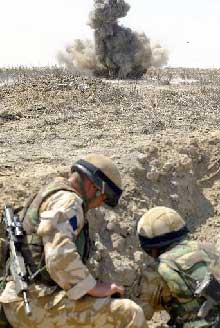
Engineers from The
1st Battalion of the
Parachute Regiment
dispose of un-
exploded bomblets
found in the desert
near their
base in the southern Iraqi
oilfields, Friday,
April 4, 2003. The
region is littered
with unexploded
ordnance including
anti-tank and anti-
personnel mines
which are detonated
in place for safety.
(AP Photo/Chris
Ison/ MOD/Pool)
|
NEAR BAGHDAD,
Iraq - U.S. troops found thousands of boxes of suspicious white powder,
nerve agent antidote and Arabic documents on how to engage in chemical
warfare south of Baghdad. But a senior U.S. official familiar with initial
testing said the materials were believed to be explosives.
Col. John Peabody,
engineer brigade commander of the 3rd Infantry Division, said the materials
were found Friday at the Latifiyah industrial complex 25 miles south of
Baghdad.
"It is clearly a
suspicious site," Peabody said.
But the senior U.S.
official, speaking on condition of anonymity, said the material was under
further study. The site is enormous and U.S. troops are still investigating
it for potential weapons of mass destruction, the official said.
"Initial reports
are that the material is probably just explosives, but we're still going
through the place," the official said.
Peabody said troops
found thousands of boxes, each of which contained three vials of white
powder, together with documents written in Arabic that dealt with how to
engage in chemical warfare.
He also said they
discovered atropine, used to counter the effects of nerve agents.
The facility had
been identified by the International Atomic Energy Agency as a suspected
chemical, biological and nuclear weapons site. U.N. inspectors visited
the plant at least a dozen times, including as recently as Feb. 18. |
The facility is part
of a larger complex known as the Latifiyah Explosives and Ammunition Plant
al Qa Qaa.
During the 1991 Gulf
War, U.S. jets bombed the plant.
Troops also discovered
what they believe is a training center for nuclear, chemical and biological
warfare in Iraq's western desert, Brig. Gen. Vincent Brooks said Friday.
One bottle found
at the site was labeled "tabun" - a nerve agent that the U.S. government
says may have been used during the 1980-88 Iran-Iraq war. The soldiers
found only a small amount of the chemical, indicating the site was meant
for training, not storing or deploying chemical weapons, Brooks said.
"In that particular
site, we believe that was the only sample," Brooks said. "That's why we
believe it was a training site. Our conclusion is that this was not a (weapons
of mass destruction) site ... it proved to be far less than that."
Photos of the site
showed shelves of brown bottles with yellow labels. Brooks said troops
did not understand some of the labels and were collecting the bottles for
examination by experts.
On April 1, Iraqi
Vice President Taha Yassin Ramadan, in a statement on Iraqi television,
repeated Baghdad's position that it had no weapons of mass destruction.
Referring to reports that gas masks and other chemical gear had been found
elsewhere in the country, he said the coalition might plant weapons of
mass destruction to implicate Iraq.
"Let me say one more
time that Iraq is free of weapons of mass destruction," he said.
"The aggressors may
themselves intend to bring those materials to plant them here and say those
are weapons of mass destruction," he said.

|
